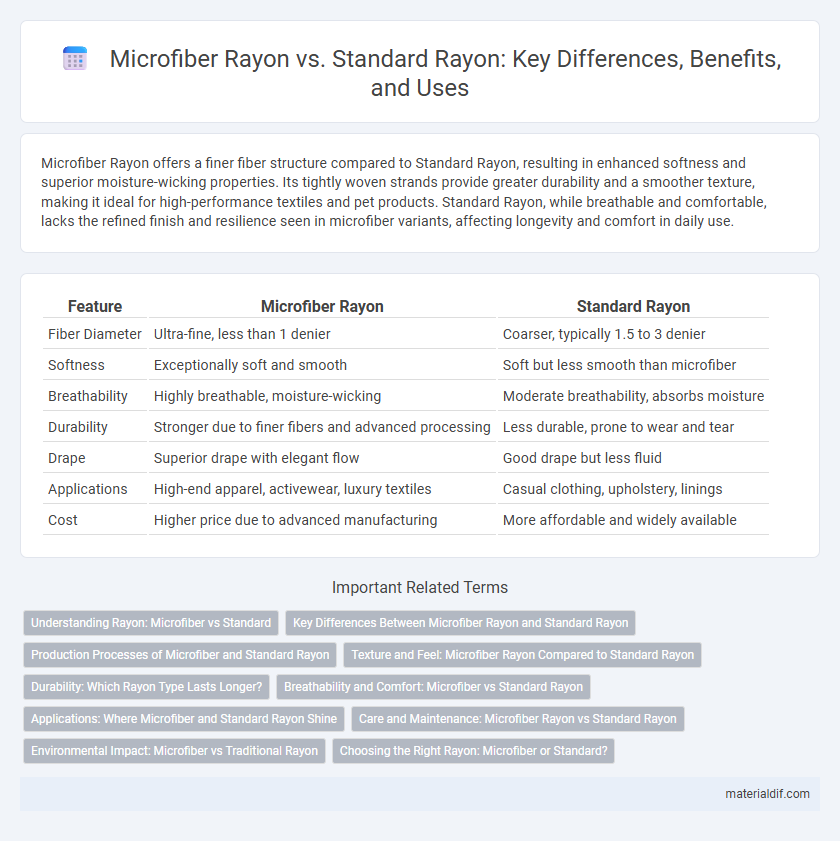Microfiber Rayon offers a finer fiber structure compared to Standard Rayon, resulting in enhanced softness and superior moisture-wicking properties. Its tightly woven strands provide greater durability and a smoother texture, making it ideal for high-performance textiles and pet products. Standard Rayon, while breathable and comfortable, lacks the refined finish and resilience seen in microfiber variants, affecting longevity and comfort in daily use.
Table of Comparison
| Feature | Microfiber Rayon | Standard Rayon |
|---|---|---|
| Fiber Diameter | Ultra-fine, less than 1 denier | Coarser, typically 1.5 to 3 denier |
| Softness | Exceptionally soft and smooth | Soft but less smooth than microfiber |
| Breathability | Highly breathable, moisture-wicking | Moderate breathability, absorbs moisture |
| Durability | Stronger due to finer fibers and advanced processing | Less durable, prone to wear and tear |
| Drape | Superior drape with elegant flow | Good drape but less fluid |
| Applications | High-end apparel, activewear, luxury textiles | Casual clothing, upholstery, linings |
| Cost | Higher price due to advanced manufacturing | More affordable and widely available |
Understanding Rayon: Microfiber vs Standard
Microfiber rayon consists of finer fibers compared to standard rayon, resulting in a softer texture and enhanced moisture-wicking properties ideal for activewear and delicate fabrics. Standard rayon, made from regenerated cellulose fibers, offers a lightweight, breathable feel but lacks the durability and smoothness of microfiber rayon. Understanding the difference between microfiber and standard rayon helps in selecting the right material for specific applications, balancing comfort, function, and fabric performance.
Key Differences Between Microfiber Rayon and Standard Rayon
Microfiber rayon features significantly finer fibers compared to standard rayon, resulting in a softer and more breathable fabric ideal for high-performance clothing and upholstery. Standard rayon typically has thicker fibers, making it less durable but more affordable, often used in everyday apparel and home textiles. The enhanced moisture-wicking properties and increased tensile strength of microfiber rayon distinguish it from standard rayon, providing superior comfort and longevity.
Production Processes of Microfiber and Standard Rayon
Microfiber rayon is produced using a finer filament extrusion process that creates ultra-thin fibers, enhancing softness and breathability compared to standard rayon. Standard rayon involves a viscose process where cellulose from wood pulp is chemically treated and regenerated into thicker fibers, resulting in a denser fabric texture. The difference in fiber diameter significantly affects the fabric's performance, with microfiber rayon offering improved moisture-wicking and durability due to its advanced production techniques.
Texture and Feel: Microfiber Rayon Compared to Standard Rayon
Microfiber rayon offers a significantly softer and smoother texture compared to standard rayon, providing a silky feel that enhances comfort in clothing and upholstery. The ultra-fine fibers in microfiber rayon create a lightweight, breathable fabric with superior drape and moisture-wicking properties. Standard rayon, while breathable and smooth, tends to have a slightly coarser texture and less flexibility in fabric movement.
Durability: Which Rayon Type Lasts Longer?
Microfiber rayon typically exhibits enhanced durability compared to standard rayon due to its finer, stronger fibers that resist wear and tear more effectively. Standard rayon, while soft and breathable, tends to be more prone to shrinking and fabric weakening over repeated washes. As a result, microfiber rayon often lasts longer in garments subjected to frequent use and washing cycles.
Breathability and Comfort: Microfiber vs Standard Rayon
Microfiber rayon offers superior breathability compared to standard rayon due to its finer fibers, which allow better air circulation and moisture-wicking properties. This enhanced airflow helps regulate body temperature, making microfiber rayon more comfortable for extended wear, especially in warm or humid conditions. Standard rayon, while soft, tends to retain moisture more readily, potentially causing discomfort during prolonged use.
Applications: Where Microfiber and Standard Rayon Shine
Microfiber rayon excels in activewear, sportswear, and performance textiles due to its superior moisture-wicking and quick-drying properties. Standard rayon finds its strength in fashion apparel, home textiles, and linings, offering softness, breathability, and drape comparable to natural fibers. Industries prioritize microfiber rayon for technical clothing while standard rayon remains favored for comfort-driven apparel and decor.
Care and Maintenance: Microfiber Rayon vs Standard Rayon
Microfiber rayon requires gentler care with cold water washing and low heat drying to preserve its fine fibers, while standard rayon tends to be more tolerant but still benefits from hand washing or delicate cycles to avoid shrinkage. Both microfiber and standard rayon should be air-dried or tumble-dried on a low setting to maintain fabric integrity and prevent damage. Proper care extends the lifespan of rayon garments by minimizing fiber wear and preserving softness and drape.
Environmental Impact: Microfiber vs Traditional Rayon
Microfiber rayon often uses synthetic fibers combined with rayon, leading to increased microfiber pollution in waterways, which harms marine ecosystems. Standard rayon, derived from natural cellulose, involves intensive chemical processing and deforestation, contributing to environmental degradation and higher carbon footprints. Choosing sustainable rayon alternatives or closed-loop production methods can significantly reduce the ecological impact of both microfiber and traditional rayon.
Choosing the Right Rayon: Microfiber or Standard?
Microfiber rayon offers superior softness, moisture-wicking capabilities, and durability compared to standard rayon, making it ideal for activewear and performance textiles. Standard rayon, derived from regenerated cellulose fibers, provides a smooth texture and excellent breathability, suited for casual and formal garments. Selecting the right rayon depends on the intended use; microfiber rayon excels in comfort and resilience, while standard rayon is preferred for lightweight, breathable fabric applications.
Microfiber Rayon vs Standard Rayon Infographic

 materialdif.com
materialdif.com